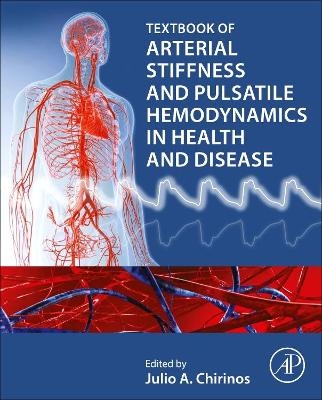
Textbook of Arterial Stiffness and Pulsatile Hemodynamics in Health and Disease
Academic Press Inc (Verlag)
978-0-12-820293-7 (ISBN)
- Titel z.Zt. nicht lieferbar
- Versandkostenfrei innerhalb Deutschlands
- Auch auf Rechnung
- Verfügbarkeit in der Filiale vor Ort prüfen
- Artikel merken
Julio A. Chirinos, MD, PhD, FAHA, FESC Associate Professor of Medicine Adjunct Faculty, Center for Magnetic Resonance and Optical Imaging University of Pennsylvania Perelman School of Medicine Associate Editor, Circulation: Heart Failure Vice-President elect, North American Artery
Section I. Biophysical and Technical Principles 1. Basic Principles of pulsatile pressure and flow phenomena in elastic vessels 2. Measurements of arterial pressure and flow in vivo 3. Essential Principles of Pulsatile Pressure-flow relations in the arterial tree 4. Magnetic Resonance Imaging for the assessment of aortic stiffness and pulsatile hemodynamics 5. Computed tomography of the aorta 6. Radionuclide-based Imaging of the aortic wall 7. Arterial wall stiffness: basic principles and methods of measurement in vivo 8. Ambulatory measurements of pulsatile hemodynamics 9. Animal Models and Ex-vivo Methods to Study Arterial Stiffness
Section II. Basic and Applied Physiology 10. Hemodynamic role of the Aorta 11. Wave Reflections in the arterial tree 12. Linking Arterial Stiffness to Microvascular Remodeling 13. Myocardial function: from myofilaments to cardiac pump 14. Systolic-diastolic coupling 15. Ventricular-arterial coupling: The pressure-volume plane 16. Myocardial wall stress and the systolic loading sequence 17. Assessment of Ventricular Arterial Interactions via arterial pressure-flow relations in humans 18. Hemodynamic Determinants of Myocardial Oxygen Demand and Supply
Section III. Biologic pathways leading to arterial stiffness and dysfunctional pulsatile hemodynamics 19. Role of elastin and elastin-derived peptides in arterial stiffness: from synthesis to potential therapeutic interventions 20. Inflammation and arterial stiffness 21. Mechanisms of Aortic Wall Calcification 22. Vascular smooth muscle dysfunction and arterial stiffness 23. Endothelial cell dysfunction and Senescence: Biologic mechanisms and Hemodynamic consequences 24. Autonomic and neuroendocrine modulation of arterial stiffness and hemodynamics 25. Cellular mechanisms of ageing and their impact on the aortic/arterial wall
Section IV. Clinical significance of arterial stiffness and pulsatile hemodynamics 26. Normal Aging: Arterial Stiffness and remodeling over the life course 27. Early Vascular Aging and Supernormal Vascular Aging: Genetics, Epigenetics, and Environment 28. Ethnic differences in arterial stiffness and central aortic hemodynamics 29. Arterial Stiffness and Pulsatile hemodynamics in Systemic Hypertension 30. Arterial Stiffness and Pulsatile hemodynamics in Diabetes and Obesity 31. Cardiovascular Risk Prevention in Clinical Practice: Current Guidelines in the USA and Europe 32. Cardiovascular Risk Prevention in Clinical Practice: Current Guidelines in Asia 33. Arterial Stiffness, Cardiovascular Risk and Strategies for enhancing risk Stratification 34. Role of the arterial tree in Physiologic Adaptations to exercise 35. Invasive Hemodynamic Assessments during exercise: Normal patterns and clinical value 36. Arterial Stiffness and Pulsatile hemodynamics in Heart Failure with Reduced and Preserved Ejection Fraction 37. Ventricular-Arterial Coupling and Arterial Load in Aortic Valvular Disease 38. Arterial Stiffness and Atherosclerosis: Mechanistic and Pathophysiologic Interactions 39. Arterial Stiffness and Pulsatile hemodynamics in Coronary Artery Disease and other forms of Atherosclerotic vascular diseases 40. Arterial Stiffness and Pulsatile hemodynamics in Renal disease 41. Arterial Stiffness, Pulsatile hemodynamics, Cognitive dysfunction 42. Arterial Stiffness and Pulsatile hemodynamics in pregnancy and pregnancy-related vascular complications 43. Arterial Stiffness and Pulsatile Hemodynamics in Pediatric populations 44. Aortopathies and Arteriopathies 45. Pulsatile hemodynamics and arterial stiffness in primary aortopathies 46. Arterial Hemodynamics and Pulsatile Hemodynamics in Congenital Heart Disease 47. Arterial Stiffness and Pulsatile Hemodynamics in Acute and Chronic Infectious Diseases 48. Arterial Stiffness, Hemodynamics and Microvascular Complications in conditions characterized by low arterial pulsatility
Section V. Therapeutic approaches to improve arterial stiffness and pulsatile hemodynamics 49. Effects of common antihypertensive treatments on pulsatile arterial hemodynamics 50. Pharmacologic approaches to reduce arterial stiffness 51. Organic and dietary nitrates, inorganic nitrite, NO donors, and sCG stimulation 52. Effect of Exercise Training and Weight Loss on Arterial Stiffness and Pulsatile Hemodynamics 53. Dietary Salt and Arterial Stiffness 54. Role of Arterial Stiffness and Central Hemodynamics in Personalized medicine in hypertension
Section VI. Arterial Stiffness and Pulsatile Hemodynamics in the Pulmonary Circulation 55. Pulsatile hemodynamics and Ventricular-Arterial Interactions in the pulmonary circulation: Physiologic Concepts 56. Pulmonary arterial load and its impact on the right ventricle in pulmonary hypertension 57. Biologic mechanisms and consequences of pulmonary artery stiffening in Pulmonary Hypertension 58. Therapeutic approaches to improve right ventricular load
| Erscheint lt. Verlag | 1.10.2021 |
|---|---|
| Zusatzinfo | Approx. 250 illustrations (125 in full color); Illustrations, unspecified |
| Verlagsort | San Diego |
| Sprache | englisch |
| Maße | 191 x 235 mm |
| Themenwelt | Studium ► 1. Studienabschnitt (Vorklinik) ► Physiologie |
| ISBN-10 | 0-12-820293-9 / 0128202939 |
| ISBN-13 | 978-0-12-820293-7 / 9780128202937 |
| Zustand | Neuware |
| Haben Sie eine Frage zum Produkt? |
aus dem Bereich


